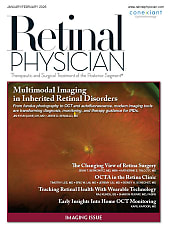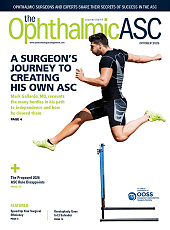“Peer Perspectives,” a new series from Retinal Physician, affords readers the opportunity to go behind the scenes and learn from editorially independent, one-on-one conversations between expert retina specialists.
In this inaugural series of conversations, Sophie J. Bakri, MD, and Roger A. Goldberg, MD, present advances in the care of patients with macular telangiectasia type 2 (MacTel). Their three-part conversation provides an introduction to the disease and covers topics including diagnosis, treatment, patient management, and more. In this second conversation, Dr. Bakri and Dr. Goldberg discuss the treatment of MacTel and patient education.
Previous Treatment Options
Sophie J. Bakri, MD: To continue our conversation about macular telangiectasia type 2 (MacTel), let’s discuss the topic of treatment. Roger, how was MacTel treated prior to the FDA approval of Encelto (revakinagene taroretcel-lwey; Neurotech Pharmaceuticals)?
Roger A. Goldberg, MD: That's a great question, Sophie. Prior to Encelto, there was no proven treatment to slow the progression of MacTel itself. All we could do was address the late-stage complications of the disease. For example, patients might develop a choroidal neovascular membrane (CNVM) that could be treated with anti-VEGF agents. But after the CNVM was treated, patients continued to experience the loss of photoreceptors that is associated with MacTel and its progression over time.
Were there any treatment options that you considered for MacTel patients prior to Encelto?
Dr. Bakri: While there were no approved treatments for MacTel, there were treatments for other retina conditions that we thought might be similar. For example, many have tried anti-VEGF injections, steroids, laser treatments, and even acetazolamide—but none of these slowed the progression of the disease.
So, I’m excited to discuss a new treatment that has been proven in clinical trials.
A Closer Look at the Encapsulated Cell Therapy
Dr. Goldberg: Encelto is going to represent an innovative technology for a lot of clinicians. Sophie, can you describe this new treatment for MacTel? What is it? How is it implanted, and how does it work?
Dr. Bakri: Encelto is the brand name for the drug revakinagene taroretcel-lwey, which was known as NT501 in the clinical trial. It's an encapsulated cell therapy that houses allogeneic retinal pigment epithelial cells, which have a unique expression vector for recombinant human ciliary neurotrophic factor (rhCNTF) release. The therapy is designed to slow the progression of MacTel by delivering long-term sustained levels of CNTF into the vitreous and retina.
Encelto is a surgical implant, about the size of a grain of rice, that we place in the vitreous cavity. It is implanted using a technique similar to that of other intravitreal implants, such as Retisert (fluocinolone acetonide intravitreal implant, Bausch + Lomb), which are sutured and anchored to the sclera. There's a prescriptive way and best practices for implanting Encelto, which I'd encourage surgeons to become familiar with prior to implanting it.
Dr. Goldberg: Great point. Even though Encelto contains “foreign” retinal pigment epithelial (RPE) cells, it does not elicit an immune response because the cells aren't distributed throughout the vitreous—they’re enclosed inside a semi-permeable membrane. This membrane keeps the cells in place, shielding them from the immune system while permitting nutrients from the vitreous to feed those cells to keep them alive. At the same time, the semi-permeable membrane allows CNTF to diffuse outward into the vitreous and ultimately reach the retina, its intended target.
Unlike another intraocular drug delivery system, where a flange keeps the sclera open, the sclera is sutured closed after Encelto is implanted, so the sclera self-seals in a manner consistent with other surgically created sclerotomies. Consequently, the complication profile associated with Encelto primarily relates to suture management. Proper surgical technique, including securely burying the knots, is essential to minimize the risk of conjunctival erosion, which typically arises from suture or knot exposure.
Sophie, in terms of the surgery and the overall adverse event profile, what stands out to you?
Dr. Bakri: First, it's a relatively safe procedure that is less complex than many surgeries performed by retina specialists. The procedure doesn't require a vitrectomy, which reduces complexity, but there are risks, such as conjunctival erosion and prolapse of the implant into the vitreous. There also is a small risk of inflammation, infection, or bleeding.
Second, data suggest the implant remains effective for at least 10 years, providing long-term therapeutic benefit. In the absence of alternative treatments for MacTel, Encelto offers a very favorable risk-benefit profile.
Tips for Patient Education
Dr. Bakri: Roger, how do you educate your patients about the treatment, and what do you tell them about the clinical trial results?
Dr. Goldberg: The way I describe the treatment to patients is that CNTF is like Gatorade for neurons. It helps keep those neurons alive, and that's why it helps protect against photoreceptor loss.
I explain to patients that clinical studies have shown that Encelto slows the loss of photoreceptors, thereby slowing the progression of this degenerative disease. With two phase 3 studies and a well-powered phase 2 study, we have a robust set of data supporting the treatment. In the combined data set, not only did Encelto slow photoreceptor loss, but it also demonstrated a reduction in the decline of reading speed and helped preserve retinal sensitivity, as measured by microperimetry. Unlike treatments for other retinal conditions—which may require monthly or bi-monthly injections to slow disease progression—Encelto is a one-time surgical procedure.
In addition to efficacy, I also discuss safety. While this is a surgical intervention, most adverse events are associated with the procedure itself and can be minimized with proper surgical technique.
Dr. Bakri: The big question patients ask is whether their vision will improve or how much deterioration can be prevented. While it’s relatively easy to discuss treatments that may improve vision, conversations about therapies that aim to slow vision loss are very difficult. Encelto is one such treatment that helps preserve vision by slowing disease progression. It’s essential to clearly communicate what “slowing vision loss” means and to set appropriate expectations. With no alternative treatments currently available, the decision ultimately comes down to whether the patient is willing to preserve vision by undergoing a relatively safe procedure.
In the next installment, Dr. Bakri and Dr. Goldberg will offer insights into patient selection for treatment, clinical data, and patient management.










